Nestled just 50 kilometers away from Hanoi, Duong Lam Ancient Village serves as a riveting window into Vietnam’s historical tapestry, boasting a legacy that stretches over 1,200 years. Recognized as the nation’s first National Heritage village, it is celebrated for its unyielding preservation of aged architecture, cultural norms, and customs. As the birthplace of pivotal figures, including kings Ngo Quyen and Phung Hung, this village represents a mosaic of Vietnam’s valiant past. Each brick within its ancient laterite structures whispers tales of resistance, unity, and an enduring commitment to cultural preservation, inviting inquisitive souls to delve into a locality where history breathes life.
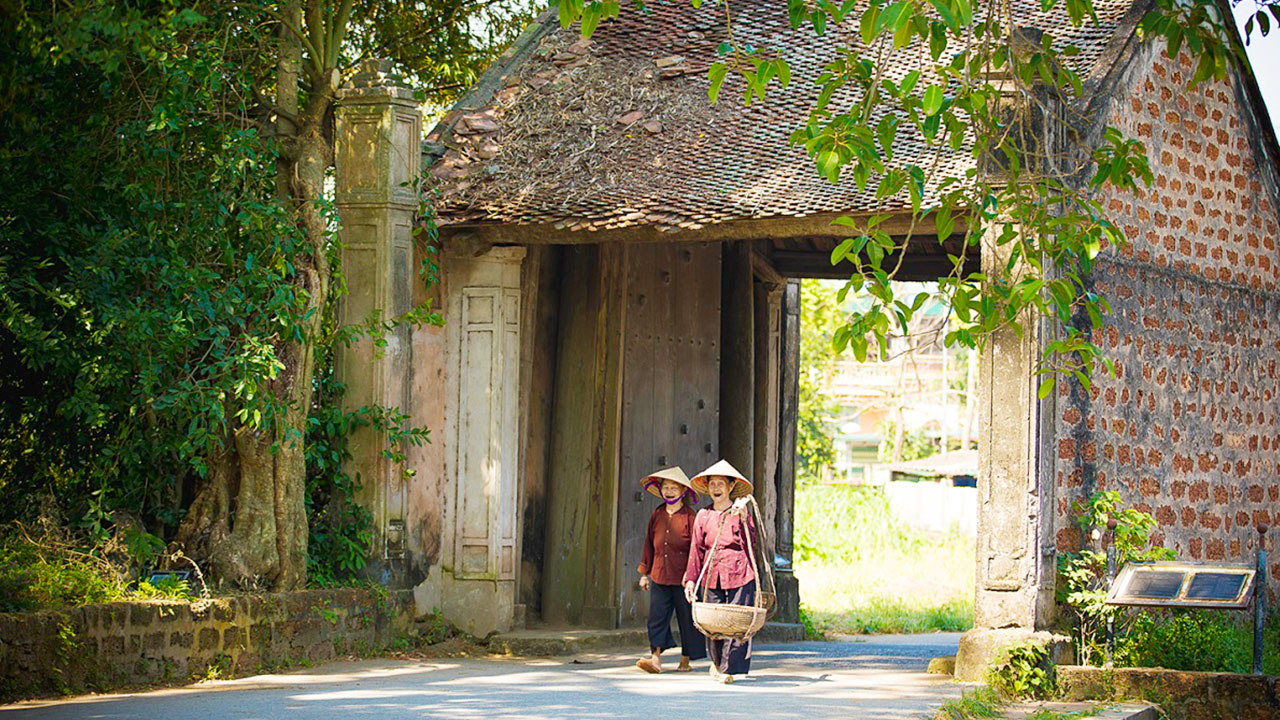
Historical Significance of Duong Lam Ancient Village
Duong Lam Ancient Village is not just a collection of historical artifacts, but a vibrant community that offers a genuine look into Vietnamese rural life. The village’s origins date back over 1,200 years, serving as the cradle of traditional practices and resistance movements that have shaped the nation’s identity. This pivotal historical backdrop paves the way for exploring the significant events that have shaped the cultural and architectural essence of Duong Lam.
Origins and Development
The foundations of Duong Lam Ancient Village are steeped in historical richness that traces back through centuries of evolving architecture and traditions. Encompassing an area enchanted by natural beauty and historical relevance, Duong Lam began its journey as a humble settlement in Vietnam’s Red River Delta. The distinct architectural features derive from the use of laterite stones, a reddish sedimentary rock, known for its durability and aesthetic appeal. This choice of material not only offered resilience against time but also imparted a unique reddish hue to the structures, seamlessly blending with the landscape.
Over the years, Duong Lam flourished as a bustling rural epicenter, characterized by bustling communal houses and shrines dedicated to ancestral worship. The village layout reflects strategic planning, fostering a sense of community around structures such as the Mong Phu communal house originally built in 1684 and now a focal point for cultural activities. Villagers practiced agriculture, with rice paddies dominating the landscape, a testament to their deep connection with the land. These practices were essential for sustaining regional folklore, traditions, and culinary techniques that would become synonymous with the culture of Duong Lam.
Today, the ongoing efforts to maintain and restore Duong Lam’s essence showcase the community’s balanced approach between maintaining tradition and embracing modernity. Preservation initiatives are supported by both national and international entities, solidifying its reputation as a cultural beacon in Vietnam.
Key Historical Events
Duong Lam’s historical significance is intricately linked to several key events that have marked the annals of Vietnamese history. A notable moment in its timeline is the birth of King Ngo Quyen within its borders. Celebrated as a national hero, Ngo Quyen’s victory in the 938 Battle of Bach Dang against the Southern Han is credited with establishing Vietnamese independence after centuries under Chinese rule. The village is home to a dedicated temple in his honor, encapsulating his contribution to the nation’s autonomy.
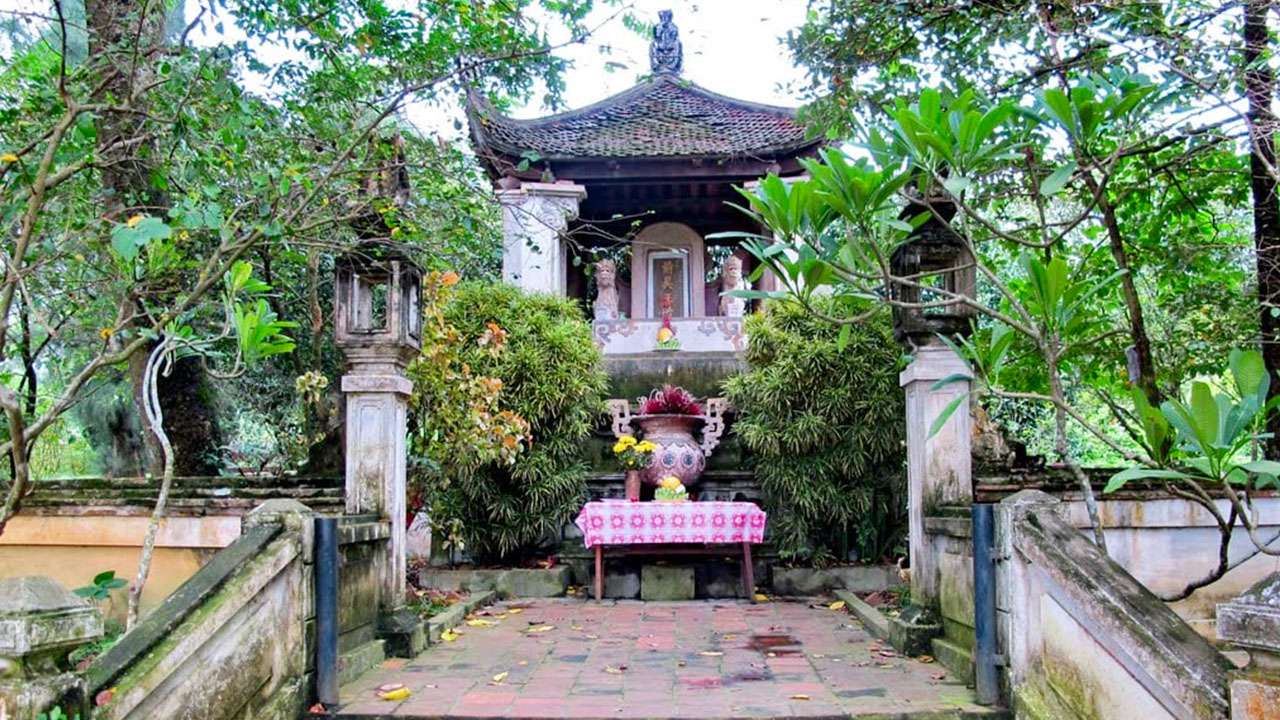
Similarly, King Phung Hung, known as the “Captain of the People,” is venerated for his leadership during a revolt against Tang Dynasty rule. His strategic prowess and empathy for the populace are commemorated in cultural rituals and festivals, reflecting his enduring legacy in societal memory. The Phung Hung Temple stands as an architectural ode to his lasting impact.
Another layer of historical intrigue in Duong Lam is its designation as a national heritage site by the Vietnamese government a recognition that acknowledges its significant cultural and architectural value. The title has fostered initiatives aimed at conserving its ancient structures, with projects backed by local and international funding, particularly from Japan. Restoration works prioritize the integrity of original materials, ensuring that Duong Lam’s historicity remains untarnished.
While these events define Duong Lam’s place in the broader historical narrative, they also reiterate the resilience of a community committed to preserving its identity. The intertwining of personal legacies and collective achievement render Duong Lam not only a site of historical education but a testament to the enduring spirit of Vietnamese independence.
Cultural Heritage Preservation Efforts
Cultural heritage preservation in Duong Lam is more than a responsibility; it is a way of life embedded into the fabric of daily existence. The community’s commitment to safeguarding its rich cultural heritage is reflected in multiple initiatives aimed at preserving the essence of village life. Notably, the village’s designation as a cultural heritage site by the Vietnamese government in 2005 marked a significant milestone, recognizing its incredible cultural and historical value.
Efforts to preserve Duong Lam’s unique architecture have been comprehensive, aimed at maintaining authenticity while accommodating modern needs. Local craftsmen, specializing in traditional techniques, play a crucial role in restoration projects, using local materials sourced sustainably. This approach not only supports environmental conservation but enables the community to maintain the traditional appearance that draws visitors from afar.
Furthermore, intangible cultural heritage, such as festivals and craft traditions, are priorities in local conservation strategies. Events like the Mong Phu Temple Festival breathe life into historical narratives through vibrant expressions of music, dance, and community camaraderie. Practices such as soy sauce and incense making are shared with visitors, offering hands-on experiences that deepen appreciation and help ensure the continuity of these traditions.
International partnerships have also been essential in advocating and funding restoration and preservation activities. These collaborations provide technical expertise and financial support that bolster the village’s capability to defend against the gradual erosion of its cultural identity.
Architectural Features of Duong Lam
The architectural landscape of Duong Lam, characterized by its unique constructions and traditional Vietnamese elements, plays a crucial role in weaving its historical narrative. With its classic structures seamlessly blending into culturally vibrant surroundings, Duong Lam stands as a testament to Vietnam’s architectural ingenuity, with roots stretching back hundreds of years.
Traditional Vietnamese Architecture
Traditional Vietnamese architecture in Duong Lam symbolizes cultural artistry and innovation meticulously crafted through centuries. The village’s architectural style is defined by wooden-framed houses and communal structures, each boasting motifs and design principles inherent to the northern regions of Vietnam. Features such as steeply sloped roofs, characteristic of the area, reflect an acute understanding of climatic adaptability providing protection against the sun and rainfall.
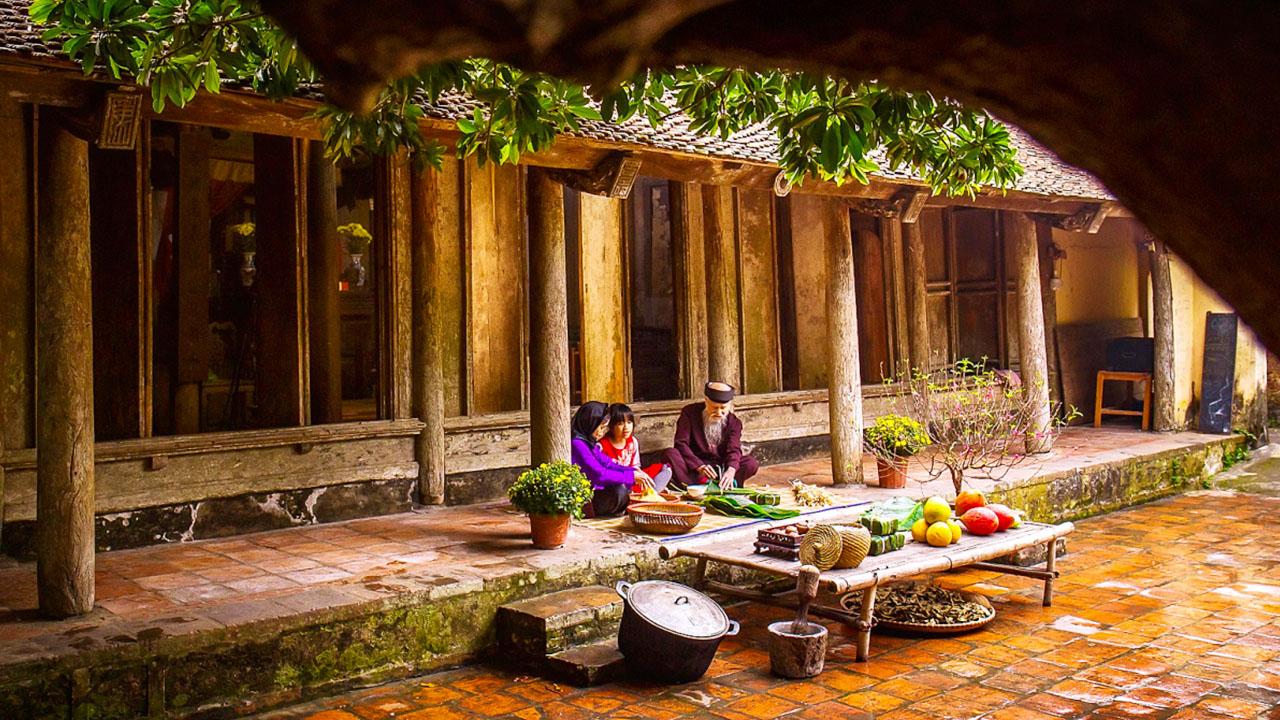
In Duong Lam, the indigenous use of laterite stone as a primary building material distinguishes its houses, adding a unique warmth and rustic beauty that mirrors the land’s natural hues. These houses typically comprise three compartments, balancing living spaces with sacred alters in the central room to honor ancestors a reflection of the intertwined relationship between spirituality and day-to-day living.
Ancient pagodas and temples dot the landscape, embracing architectural embellishments like dragon motifs and lotus symbols carved in meticulous detail. The Mia Pagoda, for example, houses an array of Buddha statues, adding spiritual depth to the village’s architectural array.
In comparison to other regional designs, the architecture at Duong Lam maintains a homogeneity that exudes cultural pride. Its minimalist yet elegant design exudes a timeless quality a compelling draw for those seeking authenticity amidst Vietnam’s rapidly modernizing environment.
Unique Houses and Structures
The architectural uniqueness within Duong Lam Ancient Village is exemplified through over 900 historical houses, each crafted with formidable precision that marries aesthetics with function. These residences possess longstanding durability thanks to the laterite stones predominant in the region. The inherent reddish tint of the stones not only embellishes the village’s aesthetic but offers insight into regional craftsmanship that highlights the ancestral ties to the land.
Duong Lam’s Mong Phu Gate serves as more than just an entrance; it is a hallmark structure signifying communal unity. Built in harmony with surrounding congregational spaces and populated with lush foliage, the gate embarks visitors on a journey into Vietnam’s living history.
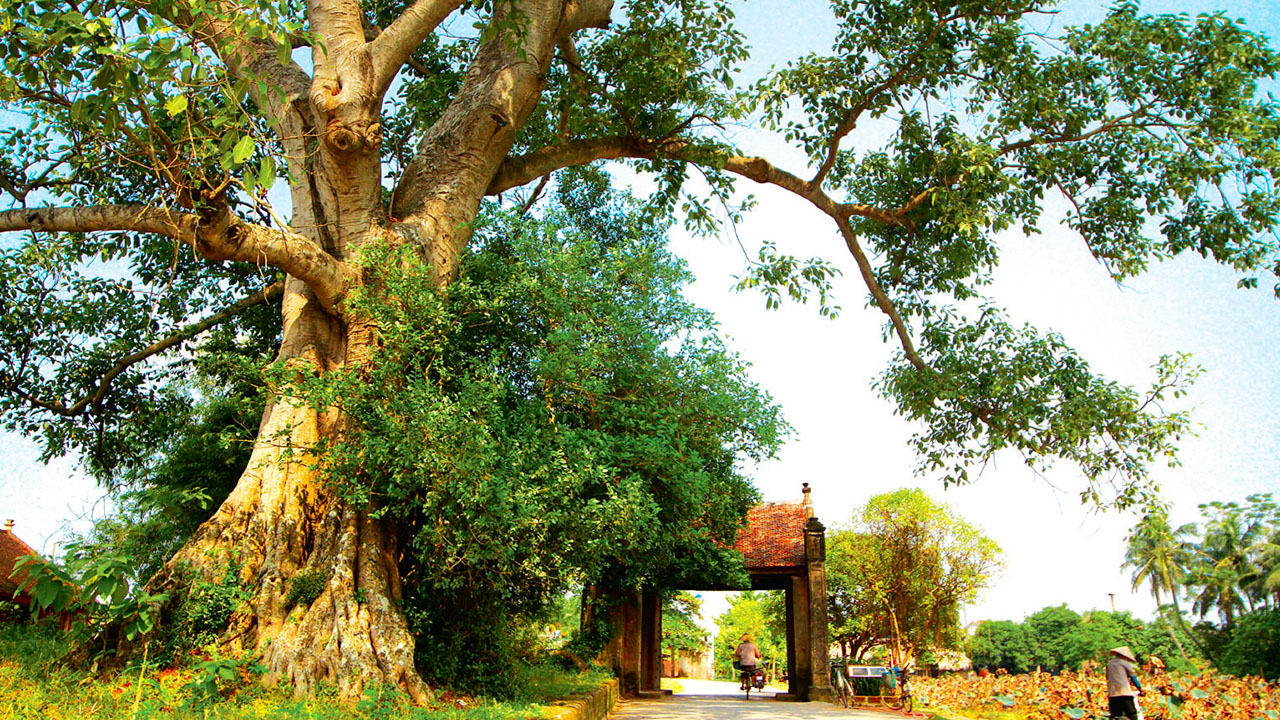
Traditional wells, scattered throughout the village, reinforce its sustainability and underscore the community’s harmonious relationship with nature. These wells were communal gathering spots integral to daily life, allowing villagers to engage socially while fulfilling essential resource needs.
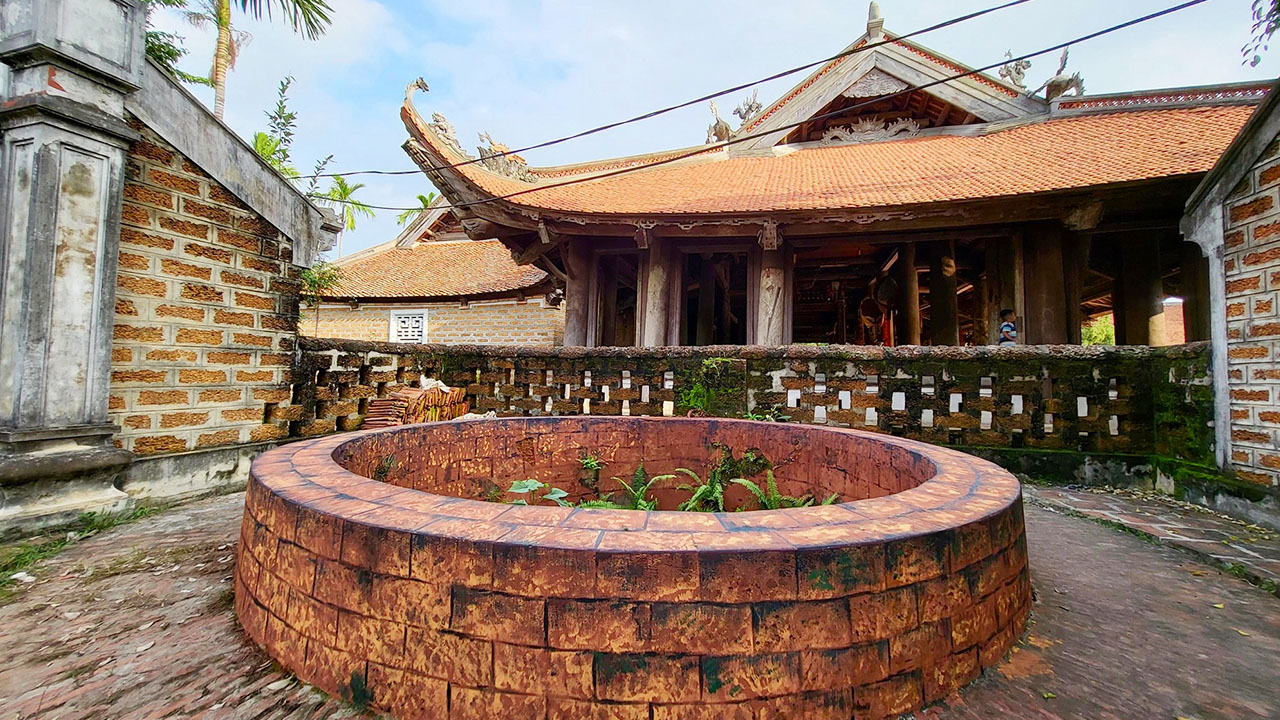
The contrast between these ancient structures and modern Vietnamese life highlights the evolving narrative of Vietnam’s architectural heritage, with Duong Lam at the forefront of cultural preservation. The attention to intricate carvings depicting local lore has preserved these homes as cultural artifacts embodying narratives that transcend time.
Influence of Region on Architecture
The architectural features of Duong Lam Ancient Village are a direct result of the region’s geographical and cultural influences, offering a unique blend that contributes to its singular style. The Red River Delta, known for its fertile soil and rich mineral deposits, presented an abundance of laterite stone, which became synonymous with the village’s architectural identity. Its resilience against erosion and thermal properties provided practical advantages, ensuring durability in Vietnam’s tropical climate.
Culturally, Duong Lam draws heavily from traditional Vietnamese architectural customs. Structures like temples and communal houses enshrine the agrarian way of life and spiritual connection evident through religious iconography and stylized motifs. The emphasis on open spaces and central courtyards in homes facilitates ventilation and communal gatherings a testament to the importance of family and social interactions in Vietnamese culture.
In comparison to other regional architectures, Duong Lam’s constructions maintain a clear distinction through their adherence to traditional forms and materials. In contrast, southern regions may emphasize openness, reflecting different climatic and cultural dynamics. This regional influence ensures that Duong Lam retains its distinctive charm and historic architecture, making it a symbolic bridge between past and future.
Cultural Practices in Duong Lam
The vibrant tapestry of Duong Lam Ancient Village is woven with its rich cultural customs and time-honored traditions. These practices, integral to the community’s identity, reflect their adherence to historic values and provide intriguing insights for visitors keen to immerse themselves in this authentic cultural experience.
Traditional Festivals and Celebrations
Duong Lam Ancient Village showcases a diverse calendar of traditional festivals celebrating its rich heritage. The Lunar New Year, or Tet, is a significant event where the village exhibits its cultural tapestry through activities ranging from ancestral worship to decorating homes with intricate banners. During these celebrations, communal meals and sharing of Bánh Chưng foster a sense of unity, while dragon dances inject vibrancy into the festivities.
The Phung Hung Temple Festival, held annually, honors the legendary leader Phung Hung. The festival is characterized by music and performance arts that breathe life into historical narratives, fostering a sense of collective memory and pride among locals and attendees alike.
These cultural events, vibrant and deeply rooted, not only preserve tradition but reaffirm Duong Lam’s cultural significance. They underscore how festive practices are integral not just to entertainment but to the spiritual and communal fabric that maintains their significance against the erosion of modernity.
Daily Life and Local Customs
The daily life within Duong Lam resonates with simplicity and authenticity, encapsulating traditional customs that have been preserved through generations. Agriculture remains a cornerstone of the economy as local farmers engage in rice cultivation with traditional methods passed down through families. These practices illustrate an harmonious relationship with the land, underscoring the importance of sustainable practices.
Residents partake in age-old culinary traditions like making Chè Lam, a sweet confectionery crafted with care and shared during social gatherings. The robust rural lifestyle is further enhanced by artisanal crafts such as soy sauce production a staple in Vietnamese cuisine. These crafts not only highlight skilled labor but provide economic sustenance through tourism-driven exchanges, solidifying the routine yet significant activities integral to local identity.
The community’s commitment to cultural preservation is reflected in their emphasis on oral traditions. Folktales, shared with visiting tourists, nurture historical consciousness and cultivate a genuine appreciation for the village’s longstanding cultural fabric.
Gastronomy and Local Cuisine
Culinary arts in Duong Lam Ancient Village offer a delectable foray into traditional Vietnamese gastronomy. Village cuisine celebrates the richness of locally sourced ingredients, exemplifying the ingenuity ingrained within Vietnamese culinary traditions. One standout specialty is thịt gà Mía free-range Mia chicken revered for its distinct taste and tenderness, often prepared during festivals as a luxurious exotic delight.
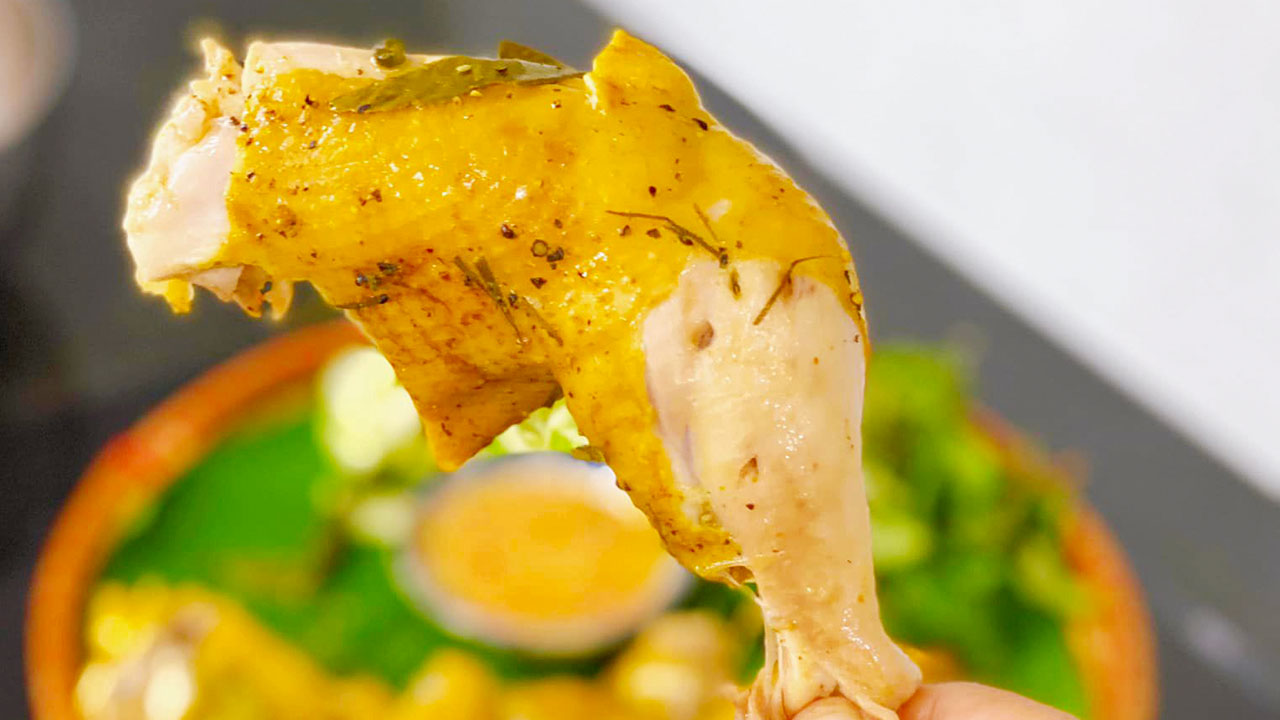
Aromatic tương bần, a fermented soybean condiment, captivates palates with its tangy complexity, weaving itself into the culinary narrative of Duong Lam. An indispensable element of Vietnamese cooking, this soy sauce embodies cultural ingenuity and locally harvested ingredients, vividly illustrating Duong Lam’s dynamic connection with its environment.
In the realm of desserts, bánh gai a unique sticky rice and mung bean confection offers a sweet endnote to culinary journeys, embraced both for its taste and cultural symbolism.
Visitors to Duong Lam are invited to engage in hands-on culinary experiences, such as cooking classes held within historic homes. These encounters provide tangible insights and ensure that gastronomic heritage flourishes amidst the vibrant pulse of village life.
Tourism in Duong Lam
The enchanting allure of Duong Lam not only lies in its architectural splendor and time-honored traditions, but also in the manifold experiences it offers visitors eager to immerse themselves in the authentic rural life of Vietnam.
Attractions and Points of Interest
Duong Lam Ancient Village presents a wealth of attractions that reveal the depth of its historical and cultural significance. The Mong Phu Gate, as both a physical and symbolic entrance to the village, welcomes visitors into a maze of narrow alleys. The rustic charm of traditional houses alongside the well-preserved communal structures instantly transports one to a bygone era.
Among the notable features, the Mong Phu Communal House, built in the 17th century, serves as a focal point for cultural gatherings and communal activities. The structure embodies traditional architectural design, featuring wooden carvings and intricate roof lines that harken back to a time when craftsmanship was revered.
Visitors can also explore the Ngo Quyen and Phung Hung temples, paying homage to the two great kings whose legacies in fighting foreign invaders are enshrined in the national consciousness. The presence of ancient wells, like those found in the community, reinforce Duong Lam’s historical roots, offering insights into social and economic organization in ancient Vietnam.
Travel Tips and Best Times to Visit
Planning a visit to Duong Lam requires thoughtful consideration of timing and preparation. The period between May and June, coinciding with the harvest season, offers picturesque scenery characterized by golden rice fields under the gentle sun a perfect opportunity for photography enthusiasts. Another optimal time is during the Tet festival in Lunar January when vibrant cultural festivities illuminate the village.
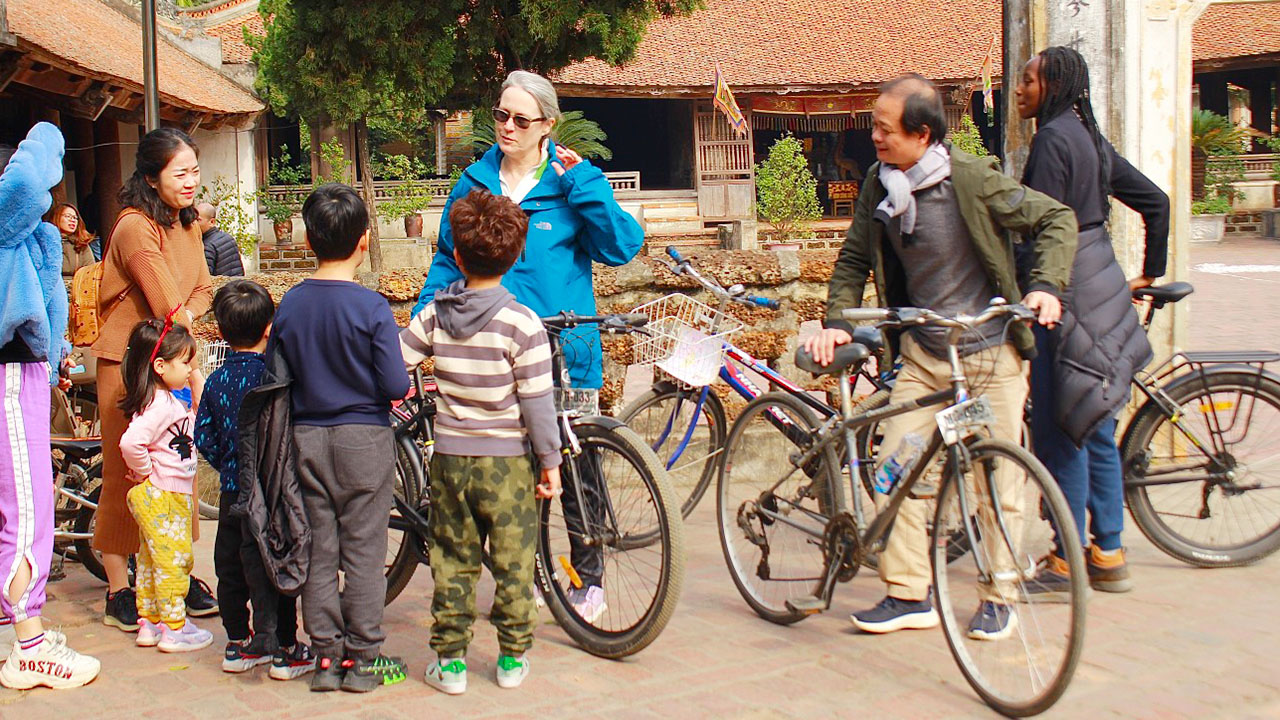
Travelers are advised to consider modest travel arrangements, such as buses or motorbikes, to fully immerse themselves in the journey that unveils the village’s natural, rustic beauty. For those preferring greater convenience, private car hires or taxis offer a comfortable alternative, allowing for exploration at one’s pace.
Respecting local customs, such as seeking permission before photographing residents or entering sacred precincts, fosters goodwill and creates a memorable journey for both tourists and inhabitants.
Impact of Tourism on Local Community
While tourism within Duong Lam has provided economic opportunities, it also presents challenges that impact the local community significantly. The flourishing tourism sector has generated jobs and income, attracting visitors who appreciate authentic experiences. Local businesses, leveraging the village’s continued heritage preservation, benefit from increased visibility and interaction with tourists keen to learn traditional crafts and culinary practices.
However, the influx of visitors brings potential environmental strains, notably in waste management and infrastructural demands. Responsible tourism practices are vital to ensure that Duong Lam retains its rustic charm and cultural integrity. Conservation efforts are continually evolving, incorporating initiatives that engage locals in dialogue with policymakers to implement sustainable solutions.
Community-led tourism fosters cultural exchanges, enriching visitors’ experiences and reinforcing pride among locals. This collaborative approach underscores a balanced relationship between economic gain and cultural preservation ensuring Duong Lam remains a cherished testament to Vietnam’s enduring heritage.
Comparisons to Other Ancient Villages in Vietnam
Tourism plays a transformative role within Duong Lam Ancient Village, mirroring efforts observed in other ancient villages across Vietnam. This proves pivotal in drawing distinctions across these cultural havens while exploring how they preserve and share history and heritage with visitors.
Duong Lam vs. Bat Trang
In comparing Duong Lam to the village of Bat Trang, one finds distinct cultural offerings that attract varying visitor interests. Duong Lam is celebrated for its well-preserved architectural structures, offering glimpses into Vietnam’s feudal past through its ancient laterite houses and communal spaces that narrative historical sagas. This makes Duong Lam a cultural emblem that resonates with history enthusiasts and those seeking an authentic Vietnamese rural experience.
Bat Trang, conversely, is renowned as the epicenter of traditional Vietnamese ceramics. Its artistic prowess is showcased through exquisite pottery and delicate porcelain crafts making it an ideal destination for individuals interested in artistic creations. Moreover, Bat Trang offers lively pottery workshops, allowing tourists to engage with artisans while gaining practical insights into this ancient craft.
While both villages highlight Vietnam’s rich cultural legacy, Duong Lam excels in preserving rural domestic policies, whereas Bat Trang thrives as an artisan economy. Together, they present diverse avenues for visitors to engage with the cultural essence of Vietnam.
Duong Lam vs. Hoi An
Duong Lam’s characteristics distinctly differ from those of Hoi An, another renowned ancient village known for its colorful lanterns and diverse architectures influenced by centuries of international trade. Duong Lam is nestled within rural landscapes, encapsulating tranquility and familial camaraderie a striking contrast to Hoi An’s bustling, vibrant marketplace atmosphere.
While both harbor historical significance, Hoi An boasts a multicultural expanse characterized by Vietnamese, Chinese, Japanese, and European architectural styles reflecting its former status as a thriving port town. This worldly blend caters to travelers seeking culinary diversity and urban historical exploration.
Ultimately, Duong Lam offers a more introspective and rural cultural experience, while Hoi An thrives as a tourist hub with lively streets and interwoven traditions.
Unique Attributes of Duong Lam
Duong Lam distinguishes itself as a remarkable cultural enclave, defined by its historical significance, architectural preservation, and community engagement. The commitment to maintaining an authentic agricultural lifestyle sets it apart from other villages that have experienced gradual modernization. Here, local residents continue to cherish ancient traditions, ensuring their continuity despite ongoing societal transformations.
A steadfast focus on preserving ancestral narratives and addressing historical impacts within communal settings renders Duong Lam a venerated ecological and cultural gem. The convergence of historical craftsmanship, vibrant festival celebrations, and harmonious integration of tourism fortifies its position as a bastion of Vietnamese identity and unity.
Environmental Aspects of Duong Lam
The picturesque landscape of Duong Lam Ancient Village markedly contrasts with Vietnam’s modernization, much like seen in its sister ancient villages. The efforts to balance preservation with environmental challenges symbolize an ongoing struggle to maintain this historical locale’s integrity amidst external pressures.
Natural Landscape and Geographical Features
Duong Lam is nestled within a layout that fosters agricultural harmony, distinguishing itself with lush rice fields and denser constructions of ancient banyan trees, offering a serene oasis for those seeking refuge from urban sprawl. Its geographical culmination at the edge of Hanoi provides a seamless transition between rural and city influences, illustrating a coalescence of environmental connectedness.
The village thrives on the nourishment offered by the Nhu Nguyet River and proximal water s, supporting its traditional farming economy and enriching habitats for diverse fauna. Such geographical assets underpin an ethos of sustainability, consistently guiding local endeavors to preserve regional authenticity.
Environmental Challenges Faced
With increasing tourism comes a heightened focus on addressing associated environmental challenges. One primary threat includes the strain on waste management systems as tourists contribute to escalating waste disposal needs. Infrastructure improvements and visitor education programs are crucial elements in mitigating environmental degradation.
Water res face challenges of pollution due to agricultural runoff, impacting both ecosystem health and community welfare. Further vulnerabilities stem from climate-induced shifts, including temperature variations and erratic weather patterns exacerbating agriculturist challenges already present within rural landscapes.
Ultimately, collaborative efforts among local communities, authorities, and visitors are crucial to preserving Duong Lam’s environmental equilibrium.
Conservation Efforts and Sustainable Practices
Conservation efforts within Duong Lam are significant, engaging multiple stakeholders to bolster architectural integrity and cultural resonance. Sustainable tourism initiatives prioritize nurturing authentic experiences, engaging visitors with local livelihoods while promoting ecological awareness *.
Preservation projects employ local artisans and traditional materials to restore ancient houses, ensuring cultural continuity while reinforcing socio-economic resilience through craft-based income opportunities. Community involvement is integral to sustainable cultural heritage initiatives that inspire ecological stewardship.
Through cultural tourism enabled by legislative safeguards and community-driven dialogues, Duong Lam is empowered to preserve its lush and verdant landscapes, thereby creating an enduring sanctuary that echoes Vietnam’s lasting values.
Frequently Asked Questions (FAQs)
- What is the significance of Duong Lam Ancient Village?
- Duong Lam holds historical and cultural significance as the birthplace of two kings, preserving its unique architecture and rich traditions that reflect Vietnam’s vibrant past.
- What types of festivals are celebrated in Duong Lam?
- The village hosts traditional festivals like the Lunar New Year (Tet) and Phung Hung Temple Festival, featuring ancestral worship, cultural performances, and communal celebrations.
- What are some local specialties of Duong Lam?
- Duong Lam is known for local dishes like Mia chicken, roasted pork with guava leaves, and the distinctive fermented soybean paste, providing a taste of authentic Vietnamese cuisine.
- How does Duong Lam compare to other ancient Vietnamese villages?
- Unlike other villages, Duong Lam is renowned for its well-preserved laterite houses and vibrant cultural heritage, offering a unique glimpse into traditional rural life.
- What steps are being taken to preserve Duong Lam’s cultural heritage?
- Preservation efforts include restoring historical structures with local materials, community-based tourism, and initiatives to protect natural and cultural res, supported by both local and international partners.
Key Takeaways
- Duong Lam Ancient Village is a historical and cultural gem, home to over 900 traditional houses and rich festive traditions.
- The village is notable for its use of laterite stones, traditional Vietnamese architecture, and rural lifestyle.
- Key historical figures, including King Ngo Quyen and King Phung Hung, are celebrated here, marking the village’s significance.
- Ongoing preservation efforts, sustainable tourism, and community engagement are crucial for maintaining its ecological and cultural integrity.
- Duong Lam offers a unique contrast to other Vietnamese villages, emphasizing historical preservation over modernization.
Conclusion
In conclusion, Duong Lam Ancient Village stands as a beacon of Vietnam’s cultural and historical tapestry, offering experiential journeys through its rich traditions and notable architecture. Its roots, deeply entrenched in the chronicles of time, are nurtured by ongoing conservation efforts that prioritize cultural integrity and sustainability. As visitors traverse through its ancient alleys, engage with community festivals, and savor authentic cuisine, they immerse in narratives that celebrate human resilience, unity, and heritage. Duong Lam’s storied legacy, intertwined with its environmental consciousness, craftily showcases a harmonious dialogue between past and present, etching its place within the broader landscape of cultural preservation in Vietnam.


